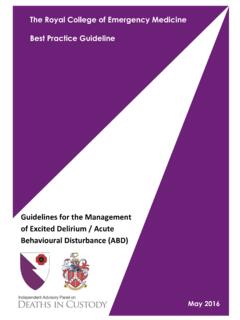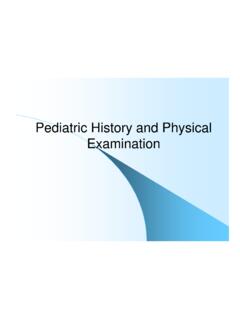Transcription of Introduction to Cancer Biology
1 Momna HejmadiIntroduction to Cancer BiologyDownload free books atDownload free eBooks at Momna HejmadiIntroduction to Cancer BiologyDownload free eBooks at Introduction to Cancer Biology2nd edition 2010 Momna Hejmadi & 978-87-7681-478-6 Download free eBooks at on the ad to read moreIntroduction to Cancer Biology4 ContentsContents1 How Cancer arises Defining Cancer Cancer is clonal in origin Insights into Cancer Causes of Cancer (aetiology of Cancer ) Identification and histopathology of cancers The 6 hallmarks of Cancer Bibliography Further reading 162 Immortality: Continuous cell division Further reading e Graduate Programme for Engineers and GeoscientistsMonth 16I was a constructionsupervisor in the North Sea advising and helping foremen solve problemsI was ahesReal work International opportunities ree work placementsal Internationaor ree woI wanted real responsibili I joined MITAS because e Graduate Programme for Engineers and GeoscientistsMonth 16I was a constructionsupervisor in the North Sea advising and helping foremen solve problemsI was ahesReal work International opportunities ree work placementsal Internationaor ree woI wanted real responsibili I joined MITAS because e Graduate Programme for Engineers and GeoscientistsMonth 16I was a constructionsupervisor in the North Sea advising and helping foremen solve problemsI was ahesReal work International opportunities ree
2 Work placementsal Internationaor ree woI wanted real responsibili I joined MITAS because e Graduate Programme for Engineers and GeoscientistsMonth 16I was a constructionsupervisor in the North Sea advising and helping foremen solve problemsI was ahesReal work International opportunities ree work placementsal Internationaor ree woI wanted real responsibili I joined MITAS because free eBooks at on the ad to read moreIntroduction to Cancer Biology5 Contents3 Sustained growth signals (oncogenes*) Bibliography Further Reading 284 Bypass anti-growth signals (Tumour Suppressor Genes*) Bibliography Further reading 335 Avoidance of cell death (apoptosis) When does apoptosis occur? What triggers apoptosis? How does apoptosis occur? Bibliography Further reading 396 Ensuring blood vessel growth (angiogenesis) Bibliography Further Reading free eBooks at on the ad to read moreIntroduction to Cancer Biology6 Contents7 Spread to other sites (metastasis) What are the stages of metastasis?
3 Key molecules involved in metastasis Bibliography Further Reading 468 Summary and some thoughts for the future Further Reading 48 Download free eBooks at to Cancer Biology7 How Cancer arises1 How Cancer Defining Cancer Cancer can be defined as a disease in which a group of abnormal cells grow uncontrollably by disregarding the normal rules of cell division. Normal cells are constantly subject to signals that dictate whether the cell should divide, differentiate into another cell or die. Cancer cells develop a degree of autonomy from these signals, resulting in uncontrolled growth and proliferation. If this proliferation is allowed to continue and spread, it can be fatal. In fact, almost 90% of Cancer -related deaths are due to tumour spreading a process called metastasis. The foundation of modern Cancer Biology rests on a simple principle virtually all mammalian cells share similar molecular networks that control cell proliferation, differentiation and cell death.
4 The prevailing theory, which underpins research into the genesis and treatment of Cancer , is that normal cells are transformed into cancers as a result of changes in these networks at the molecular, biochemical and cellular level, and for each cell there is a finite number of ways this disruption can occur. Phenomenal advances in Cancer research in the past 50 years have given us an insight into how Cancer cells develop this autonomy. We now define Cancer as a disease that involves changes or mutations in the cell genome. These changes (DNA mutations) produce proteins that disrupt the delicate cellular balance between cell division and quiescence, resulting in cells that keep dividing to form Cancer is clonal in originCurrent dogma states that Cancer is a multi-gene, multi-step disease originating from a single abnormal cell (clonal origin) with an altered DNA sequence (mutation).
5 Uncontrolled proliferation of these abnormal cells is followed by a second mutation leading to the mildly aberrant stage. Successive rounds of mutation and selective expansion of these cells results in the formation of a tumour mass (FIG a & b). Download free eBooks at to Cancer Biology8 How Cancer arisesFigure a: Clonal expansion. Cancer is a multi-gene, multi-step disease originating from single abnormal cell (clonal origin). Changes in DNA sequences result in the cell progressing slowly to the mildly aberrant stage. Successive rounds of mutation & natural selection leads to a mass of abnormal cells called tumours. Some cells in the tumour undergo further rounds of mutations leading to the formation of malignant cells which cause metastasis. (Fig source: M Alison. )Subsequent rounds of mutation and expansion leads to tumour growth and progression, which eventually breaks through the basal membrane barrier surrounding tissues and spreads to other parts of the body (metastasis).
6 Death as a result of Cancer is due to the invading, eroding and spread of tumours into normal tissues due to uncontrolled clonal expansion of these somatic : Clonal expansion. Normal cells are subject to signals that regulate their proliferation and behaviour. All cancers disrupt normal controls of cell proliferation & for each cell there is a finite number of ways this disruption can occur. Cancer cells develop a degree of autonomy from external regulatory signals that are responsible for normal cellular homeostasis. Multiple mutations lead to a tumour mass. Subsequent mutations lead to malignant tumour which break through the basal membrane and spread to distant locationsDownload free eBooks at to Cancer Biology9 How Cancer arisesEvidence for the clonal expansion model can be demonstrated with a simple but striking clinical example (FIG ).
7 The enzyme, glucose-6-phosphate dehydrogenase (G6PD) has two forms, G6PD-A and G6PD-B, which differ from each other by 1 single amino acid. Some people have cells that contain either type A or type B but no cell contains both, hence tissues are a mosaic of cells with these two types. Individuals who develop Chronic Myeloid Leukaemia (CML a blood Cancer ) contain cancerous myeloid cells which all contain only one type of the enzyme, either type A or type B, but never both, clearly demonstrating that cancers are clonal in origin. Normal tissue contains both type A & B ofG6 PDTUMOURS contain either type A & B of the G6PD, never both Figure : Example showing cancers are clonal in origin. Genetic analysis of myeloid cells in some patients with Chronic Myeloid Leukaemia (CML a blood Cancer ) contain only one type of the enzyme, G6PD, either type A or B, but never both.
8 Since normal tissues on the other hand, are a mosaic of cells with both type A & B, this clearly demonstrates the clonal origins of Insights into cancerInitiation and progression of Cancer depends on both external factors in the environment (tobacco, chemicals, radiation and infectious organisms) and factors within the cell (inherited mutations, hormones, immune conditions, and mutations that occur from metabolism). These factors can act together or in sequence, resulting in abnormal cell behaviour and excessive proliferation. As a result, cell masses grow and expand, affecting surrounding normal tissues (such as in the brain), and can also spread to other locations in the body (metastasis). However, it is important to remember that most common cancers take months and years for these DNA mutations to accumulate and result in a detectable Cancer .
9 Download free eBooks at to Cancer Biology10 How Cancer arisesCancers arise approximately in one among every 3 individuals. DNA mutations arise normally at a frequency of 1 in every 20 million per gene per cell division. The average number of cells formed in any individual during an average lifetime is 1016 (10 million cells being replaced every second!). It would therefore be logical to assume that human populations anywhere in the world would show similar frequencies of Cancer . However, Cancer incidence rates (number of individuals diagnosed) vary dramatically across countries. Evidently, some factors seem to intervene to dramatically increase Cancer incidences in some populations. The obvious inference is that contributory factors that cause Cancer are either hereditary or environmental.
10 It means that either certain populations carry a large number of Cancer -susceptibility genes or that the environment in which populations live largely contribute to the Cancer incidence rates. Causes of Cancer (aetiology of Cancer )Which of the two genes or the environment play a dominant role in developing Cancer ? While genes are distributed unequally across populations, they do not explain the differences in Cancer incidence rates in the world. This is demonstrated by most dramatically in this example. Incidences of stomach Cancer are 6 8 times higher among Japanese compared to Americans. However, children of migrant Japanese settled in America show incidence rates of stomach Cancer comparable to that of the American population. Therefore, the risk of developing Cancer seems largely environmental, accounting for more than 90% of all cancers caused.

